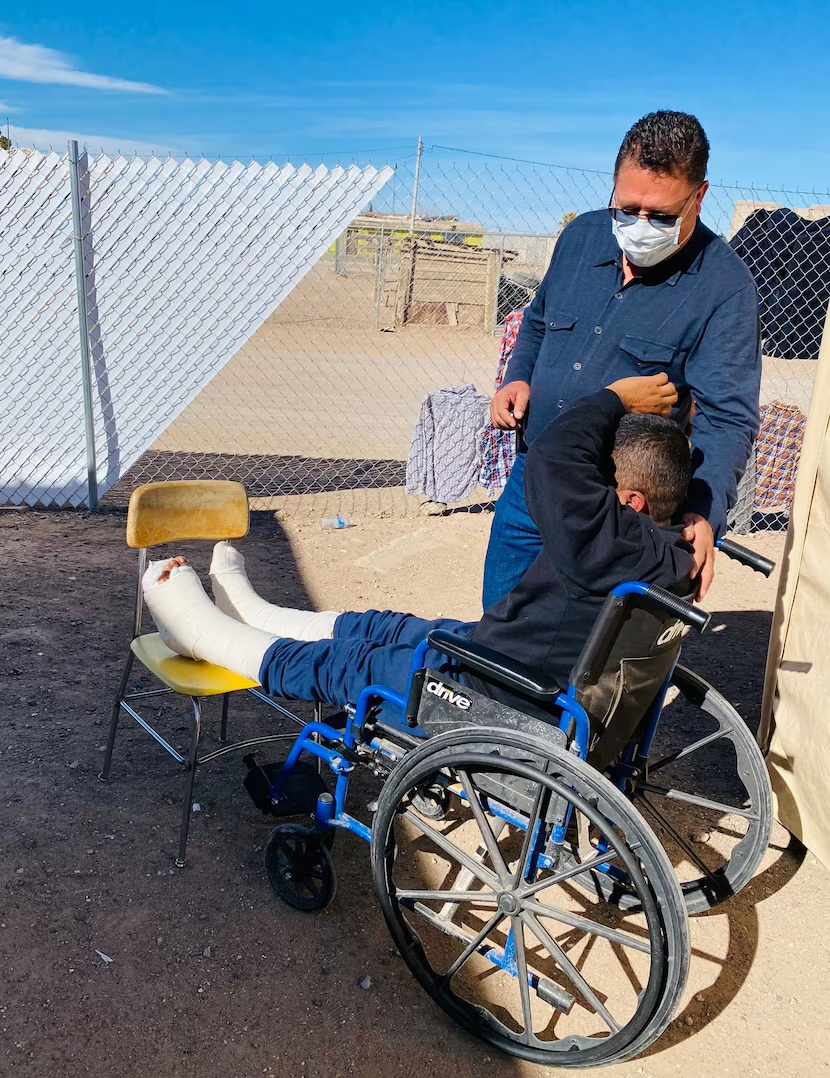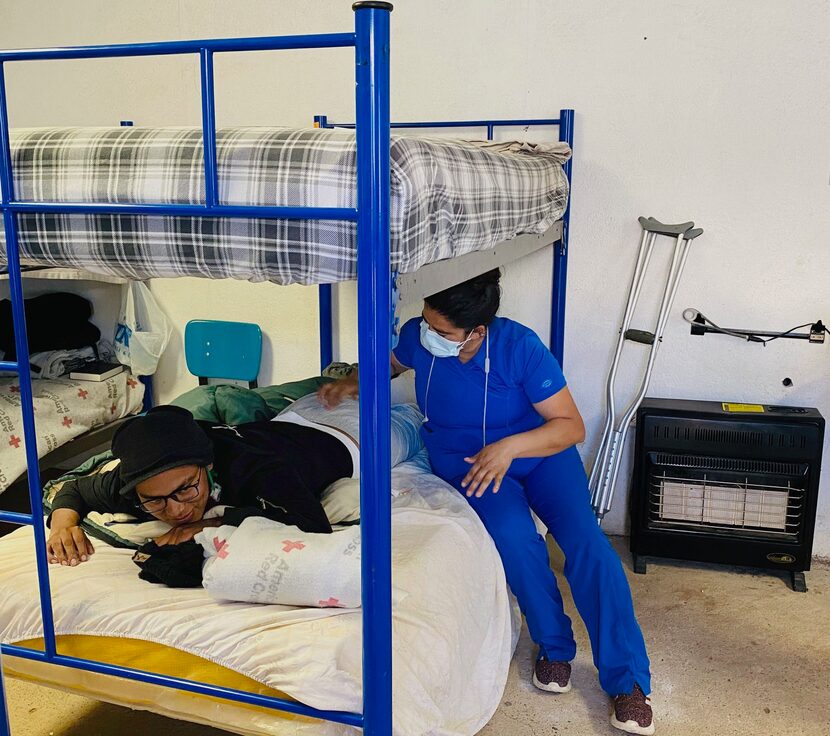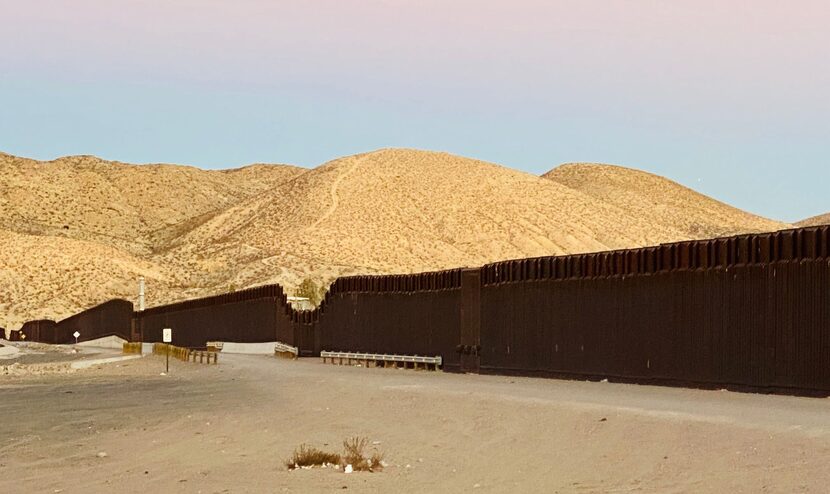PALOMAS, Mexico – To escape the lingering, devastating effects of two hurricanes and the reach of organized crime, Pedro Gomez fled Guatemala in January and headed north, looking for hope.
Thousands of miles south, Jhon Jairo Ushca Alcoser, too, left his country, Ecuador, fleeing political unrest and the economic fallout of a global pandemic that’s ravaged his nation.
For both men, it seemed as if nothing would stand in the way of their cherished dream – certainly not deserts, rivers, unscrupulous smugglers, or the infamous wall they had heard so much about. But then that same wall nearly crippled them. And they say the migra -- the U.S. Border Patrol -- then “dumped us in Mexico like garbage, a piece of trash,” said Pedro Gomez, 37. They say agents who discovered them injured sent them back across the border rather than providing them medical care on American soil.
“When I fell off the wall, my dream crashed too,” said Ushca Alcoser, 25, who this week shared his story from a bunk bed a few feet away from Gomez, inside a migrant shelter in this desolate border town across from Columbus, New Mexico. Ushca Alcoser said his complaints to agents of his pain “fell on deaf ears.”
The men’s perilous journey underscores the rising desperation among immigrants in trying to cross into the United States, immigrant rights advocates say, and raises questions about the protocols used by the Border Patrol to treat injured migrants and the overall effectiveness of the border wall.

After being asked about the men’s cases and how the Border Patrol handles injured migrants, the agency released a statement attributed to El Paso Sector Border Patrol Chief Gloria Chavez that read, in part: “We routinely encounter injured people on the border, most of which are individuals that have entered the country illegally. When it is apparent that someone is hurt we will administer first aid and request assistance as needed.”
The statement said that the response “may include a Border Patrol agent trained and certified as an EMT; or possibly an ambulance service depending on the severity and complexity of the injury” and, if necessary, an agent accompanying and monitoring “the progress at the medical facility until they are cleared and released for processing.”
It’s not clear why these injured migrants were deported to Mexico, even after both said they told agents they couldn’t walk.
“I couldn’t even get up, so I crawled inside the migra vehicle,” said Gomez, after falling off the wall in late January. At one point, he says he was told he was going to be taken to a U.S. hospital, but instead was dropped off at the border crossing nearly 90 miles from where he fell off the wall near El Paso. His ankles are broken ankles and he cannot walk.

Ushca Alcoser said he told Border Patrol agents he couldn’t move and was “screaming in excruciating pain” after he fell backwards off of a 30-foot section of the wall newly installed during the Trump administration as Border Patrol agents stood in front of him in early February.
But “they said ‘stand up, stand up.’ I don’t know where I found the strength.” He says he was sent back to Mexico, dragging his feet as another migrant held him up. X-Rays later revealed broken tendons and a fractured back and pelvis, Sosa said.
The two men asked their names be used so their accounts of events can be verified.
The Border Patrol said “records indicate that neither individual you mention presented illness or injury during their brief encounters with our agents.” The statement added that agents “perform their jobs with the utmost professionalism and display a high level of respect and dignity towards the many people that are encountered daily” and encouraged anyone who “believe they have been mistreated” to file a complaint.
Separately, a Border Patrol spokesman said the agency does not track injuries related to the wall.
Jumping over barriers isn’t new, but dumping injured migrants back to Mexico is a “new low. It’s called negligence,” said Pastor Rosalio Sosa, who runs the Red de Albergues Para Migrantes, or RAM, a network of migrant shelters, including the one here in Palomas where the men were interviewed. This shelter – Tierra de Oro or Land of Gold – is about two hours west of El Paso.
Sosa says since his shelter opened in Palomas nearly a year ago, they have seen about seven injuries per week, both minor and severe, from migrants hurt along the stretch of land from Arizona to New Mexico where it meets West Texas. He said he has documented the cases and pleads with Border Patrol agents to be “more responsible, more humane, because many more are coming.”

Sosa and others are bracing for a sharp increase in the number of migrants in the coming days and weeks in this region as winter ebbs and the economic effects of the coronavirus pandemic worsen across Latin America, a region already plagued by corruption and organized crime. Plus, Sosa said, there’s renewed hope the new Biden administration will treat migrants more humanely, “giving rise to hope.”
On Thursday, President Joe Biden informed Congress that he has terminated the national emergency over the U.S.-Mexico border that former President Trump first declared in Feb. 2019, declaring “no more American taxpayer dollars be diverted to construct a border wall.”
That and a loosening of many of Trump’s widely criticized draconic immigration policies are expected to lead to an increase in the number of migrants headed north for refuge or work. So many are expected to come that local officials here in Palomas, a town with only one fully paved main road, just added a clinic.
As Sosa walks around his shelter he points to the injured and says, “This has become a war zone, with war injuries and no resources.” He added: “But governments need to know that deserts, rivers, walls are no match for hunger.”
From afar on highway 9 between Columbus and El Paso, Trump’s “big, beautiful wall” looks menacing, cutting like a wound along the Chihuahuan desert. Border Patrol vehicles roam the desert. Two migrants run through the brush. The wall is 30 feet high into the sky.
This means the wall is “at least three times taller, higher than an average person and the height results in multi-system trauma… primarily leg fractures, ankle fractures, but also a lot of spinal neck and head injuries as well as deaths,” said Ieva Jusionyte, author of Threshold: Emergency Responders on the U.S.-Mexico Border and associate professor of international security and anthropology at Brown University.
The wall was supposed to be a key deterrent, Jusionyte added, “so that the more difficult you make it for people to come across without authorization, the thinking was,” the more “people would get injured and people would die. So then others would be discouraged to follow in their tracks. But that just hasn’t happened. And the border infrastructure is getting deadlier and people’s reasons for moving are increasing, as well. So it is just a bad combination.”
Both men were swiftly returned to Mexico under title 42, a pandemic policy enacted by the Trump administration to control the spread of COVID-19. The policy has created a revolving door and providing an “an infinite number of attempts,” said Andrew Selee, president of the Migration Policy Institute
Gomez began planning his trip north immediately after two hurricanes hit Central America last fall. He borrowed money from friends and family and waited for the holidays to end before making his way across Mexico. Today, he sits in a wheelchair, his ankles broken and in a cast. He sobs loudly, and he feels shame when he remembers falling from the wall. He said his injury will not break his resolve to cross into the United States.
“I promised my family I wouldn’t come back until I can put a roof over their heads,” he said, recalling the words he told his four children and his wife back in Guatemala.
Two migrants, both Hondurans who asked that their names be withheld because they may try to cross into the U.S. again, helped Gomez cross back into Mexico when he was injured. They haven’t left his side since that evening in January. They help him bathe, undress, and give him pep talks.
“You’ll walk soon and we’ll continue our journey,” said one, who along with the other Honduran were picked up by the Border Patrol in the desert after they ran out of water and gave up.
“Next time, we’ll carry enough water,” he quipped.
“I have bad news,” added Sosa. “You won’t walk. You will run again.”
Ushca Alcoser, a barber, says he stares off into the distance most of the day. He dreads telling his family back in Ecuador “what really happened” because he doesn’t want to worry them, especially “mommy, who has been ill.”
A day after they were interviewed, both men were transported to a hospital some 100 miles away. They were X-rayed and were told Thursday that the injuries to their ankles, legs, pelvis and back will take as much as four to six months to heal. Ushca Alcoser, finally broke down and called his parents. He told them about falling from the wall and how the Border Patrol showed no mercy on him.
“I told my son, why humiliate yourself there more, come home,” said his father Segundo, in a phone interview., explaining leaving for the U.S. was once his dream too. “We’re poor here, but we still have dignity. But he just cries and says he wants to work in the United States. There is no future for him here. He’s young, full of illusions, hopes and dreams.”


